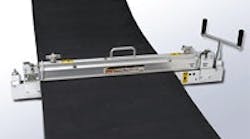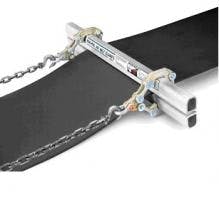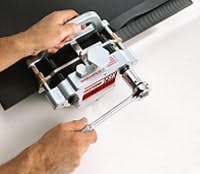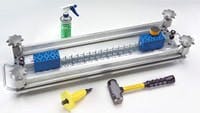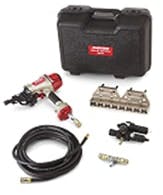The familiar adage, “time is money,” still holds true for conveyor operation. Keep them moving and productivity moves forward. Stop them and productivity stands still, sometimes for extended periods while repairs are performed. Even worse, faulty, hastily performed repairs often cause recurring problems and more extended downtime.
Adjustable belt clamps keep a sturdy, steady grip on belts to 1.5 inches (38 milimeters) thick.
Safe, practical repairs performed with a variety of on-site maintenance tools enable efficient, effective repairs that minimize maintenance and maximize productivity. Choosing the right combination of tools, using them properly and avoiding shortcuts is the formula for success.
The range of available tools includes products to perform the repair, as well as equipment that provides an effective work surface and environment for making on-site repairs. For the sake of convenience and effective on-site repairs, here are some tools and procedures that all maintenance personnel should regard as indispensable to efficient operation, and should always have on hand.
Get repair ready
As with nearly every maintenance task, proper preparation pays off in terms of safety and successful belt repair. Fully adjustable belt clamps provide even tensioning across the entire belt width, keeping a sturdy, secure grip on belts up to 1 inch (25 milimeters) thick. Adjustability enables these tools to fit a variety of widths while eliminating the need to inventory different bars for different widths. Models made from extruded aluminum make the clamps lightweight and easy to use.
Straight, square cuts
Portable, lightweight belt cutters contribute to straight, square cuts, and eliminate the guesswork and potential danger of cuts with a utility knife.
Straight, square cuts are an essential starting point for effective, lasting belt repairs. Using a utility knife for this important task just won’t cut it. In fact, the imprecise cuts made with a utility knife will invariably complicate and lengthen the repair process. In addition to being potentially dangerous for this purpose, a utility knife becomes more of a repair obstacle than a repair instrument. Effective belt repairs start with straight, square cuts. Doing the job with a knife is both inexact and potentially unsafe. What’s more, the wider the belt, the greater the margin for imprecision, error and injury.
Portable, lightweight belt cutters make it easier to achieve straighter, squarer cuts, and to do so with more uniformity and safety. Their use helps maximize mechanical fastener splice life and minimize downtime because a properly squared belt distributes tension evenly across the splice. With belt ends properly squared, the problems associated with mistracking, such as premature belt and splice wear, load spillage and fastener pullouts, are less likely to occur.
Belt cutters are designed for belt thicknesses ranging up to 1.5 inches (12-38 millimeters), and for belt widths up to 84 in. (900-2,130 millimeters). By itself, the belt-cutting procedure is not appreciably faster than alternate methods. Preliminary steps to properly measure and square belt ends still need to be taken — regardless of the cutting method. Instead, savings associated with a belt cutter stem from avoiding the time-consuming complications associated with imprecise cuts and the need to repeat the process.
Successful skiving
Fully portable skivers provide uniform, precise removal of the conveyor belt’s top cover, while prolonging the operating life of fasteners and cleaners.
Portable belt skivers also take the guesswork out of belt preparations for countersunk fasteners. They effectively remove the conveyor belt’s top cover with uniform precision. As with belt cutting tasks, the job is no place for a utility knife. Not only is safety compromised when a knife is used, so is the effectiveness of the belt. Lightweight, fully portable skivers help ensure quick, safe and accurate top cover removal at various depths. This, in turn, enhances fastener reliability, eliminates the danger and imprecise cuts that can result from hand-knife skiving. It is also a cleaner and faster alternative to a router, since the skiver removes the top cover as one continuous strip, and does so in only a few minutes.
Another benefit comes when fasteners interface with belt cleaners. Both are essential tools in productive conveyor belt operation. While each fulfills a different role, they must operate as a team. When fasteners are countersunk, fastener top plates are positioned flush to the conveyor belt’s top cover. Impact between cleaner blades and fasteners is virtually eliminated, enabling cleaners to operate more effectively, while adding to the operating life of both the cleaner blades and the fasteners. There are other residual benefits. The operation is quieter because fastener contact with the cleaner is minimized.
With the models being lightweight and operating without electrical power, this fully portable, compact tool pays off again and again in terms of belt performance and overall productivity.
Faster fastener installation
Portable, lightweight installation tools, such as Flexco’s MBRT, can significantly reduce fastener installation time.
A range of time-saving application tools are available to strengthen, speed and simplify fastener installation. Lightweight aluminum installation tools are designed for portability and heavy-duty use. They are well suited for high tension, harsh environment applications and are a welcomed addition, whereas heavy splicing equipment has to be moved on a regular basis. For example, a recently introduced MBRT installation tool can reduce installation time of Flexco’s BR solid plate fasteners by up to 40%.
Installation time also can be slashed and operator efficiency enhanced when these tools combine with collated rivet strips that hold multiple rivets at one time. This enables the entire guide block to be loaded with one strip of collated rivets.
A variety of portable, power-driven belt repair tools also are available. Operating like a drill or impact wrench, electric rivet drivers are designed for easy operation. They eliminate the potential dangers associated with manual hammering and also simplify repairs in locations with tight clearances.
Collated rivet sets designed for use with specific electric rivet drivers further speed splice installations. Tests have shown that some of these rivet strips carry as many as 24 for the BR6 and 20 for the BR10 rivets and can be loaded and ready for use in just 5 seconds. When rivets are loaded individually the process takes about 35 seconds.
